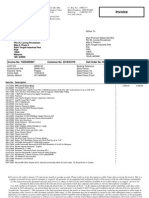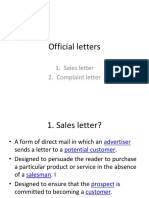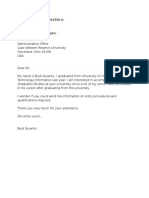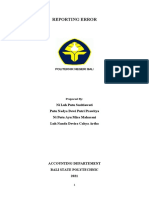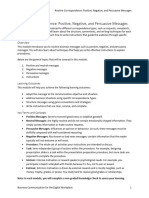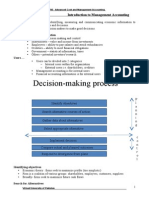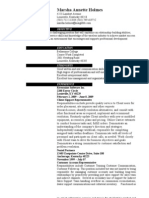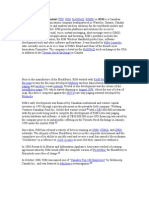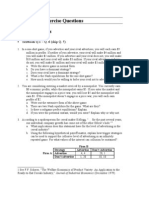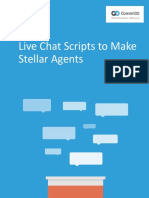Positive Replies: Good News and Neutral Messages
Positive Replies: Good News and Neutral Messages
Uploaded by
sweet haniaCopyright:
Available Formats
Positive Replies: Good News and Neutral Messages
Positive Replies: Good News and Neutral Messages
Uploaded by
sweet haniaOriginal Title
Copyright
Available Formats
Share this document
Did you find this document useful?
Is this content inappropriate?
Copyright:
Available Formats
Positive Replies: Good News and Neutral Messages
Positive Replies: Good News and Neutral Messages
Uploaded by
sweet haniaCopyright:
Available Formats
Eng 209/WI
Hurley
Positive Replies: Good News and Neutral Messages
Good news messages convey good news for the reader. Neutral messages don't convey happy news, yet they are good news in that the reader will not be disappointed. These are messages that will be received favorably by our reader and use the direct approach. Good news letters use the Direct Approach. Since we know the reader will be glad to accept the message, we use the direct approach which states the good news up front. 1. begin with the main idea: the good news. 2. don't begin by introducing yourself or the reason why you're writing. That can come later. I. Main Idea: Initial Statement of Good News or Main Idea Positive opening telling the reader what s/he wants to hear first (credit granted, shipment sent, favor accepted, request granted) Courteous comment, appreciation for remittance/order, congratulations Verification of information: description, costs, quantity, charges, dates, delivery All needed details (answer all questions, including 5 Ws, give complete instructions, stress reader benefits, positive emphasis, helpful Resale material, with reader benefit, when appropriate (emphasize what company can do for the reader, give reader choices) Educational material (explain product use, legal aspects, confidentiality, directions for filling out forms, instructions) Sales promotion, if appropriate (give needed details on products and services) For Order Acknowledgments 1. Begin by expressing appreciation for the order and welcome the new customer. Describe the merchandise ordered in general terms. Indicate in your first sentence that you are fulfilling the reader's request. 2. In the body, provide all necessary educational information about the product. Give details of shipment, including approximate arrival time. Explain charges (shipping, insurance, credit charges, or discounts for quick payment). Provide Information about related products, and credit application, if appropriate. 3. In the closing, remind the reader of the benefits to be derived from the order.
II. Explanation, which may include:
Eng 209/WI
Hurley
For Favorable Responses to Claims and Adjustment Requests 1. Immediately state your willingness to honor the reader's claim, without negative comment. Accept your reader's account as entirely accurate unless good business reasons demand a different interpretation of some points. Thank the reader for taking the time to write. 2. In the body, explain how you will remedy the problem. Minimize or, if possible, omit any disagreements with your reader's interpretation of events. If appropriate, provide an objective, non-vindictive, impersonal explanation. Apologize only under extreme circumstances. Maintain a supportive tone through such phrases as "Thank you for;' "May we ask," Please let us know;" and "We are glad to work with you." Admit your firm's faults carefully. Avoid shifting the blame to others, implying general company inefficiency, and making unrealistic promises about the future. Be careful when handling the customer's role in producing the problem. 3. In the closing, remind the reader how you have honored the claim and clarify any actions that your reader must take. Encourage the customer to look favorably on your company or the product in question. Encourage the customer to continue buying other goods from you but avoid seeming greedy. Clarify any actions that your reader must take.
III. Positive, Friendly Closure
Appreciation to reader Clear statement of action desired; easy action (offer of further help, enclosed forms or envelope); Willingness to help further Forward look to future use of goods and services, Good wishes, compliment or request
Begin your letters effectively. Do not start letters with "I" or "We." End with a specific polite closure. Avoid "contact" when "call me" or "email me" are more precise. Credits Writing Routine, Good News, and Goodwill Messages PowerPoint presentation by Courtland Bovee, John Thill, and Barbara Schatzman, Business Communication Today Bovee and Thill, Business Communication Today M.E. Guffey, Essentials of Business Communication Kitty Locker, Business and Administrative Communication Leslie Munro Eng 209 Booklet
You might also like
- AffidavitDocument3 pagesAffidavitLoida Torralba SerranoNo ratings yet
- PDFDocument4 pagesPDFNandhini RaviNo ratings yet
- ISA 315 & ISA 240 (Fraud and Risk)Document54 pagesISA 315 & ISA 240 (Fraud and Risk)Joe SmithNo ratings yet
- Epilogue: The Story of Macroeconomics: Prepared By: Fernando Quijano and Yvonn QuijanoDocument32 pagesEpilogue: The Story of Macroeconomics: Prepared By: Fernando Quijano and Yvonn Quijanosweet haniaNo ratings yet
- Chapter 3 - Selling On The WebDocument49 pagesChapter 3 - Selling On The WebDanGrutas100% (1)
- Curs 2Document47 pagesCurs 2Karla DanaNo ratings yet
- Main-Topic-3 2Document9 pagesMain-Topic-3 2Alliah AldayNo ratings yet
- Bad News MessagesDocument27 pagesBad News Messagesذوالفقار علی شاہNo ratings yet
- Directness in Good News and Neutral MessagesDocument21 pagesDirectness in Good News and Neutral Messagesmotu theNo ratings yet
- Course Code:EGL113 Course Title: English Writing SkillsDocument39 pagesCourse Code:EGL113 Course Title: English Writing SkillsIrshad QaziNo ratings yet
- Bad News MessagesDocument13 pagesBad News MessagesHamza KhalidNo ratings yet
- Business Correspondence Task 2Document2 pagesBusiness Correspondence Task 2ANDI SAPUTRANo ratings yet
- Business Communication - EnG301 Power Point Slides Lecture 23Document18 pagesBusiness Communication - EnG301 Power Point Slides Lecture 23ahtishamelahi40No ratings yet
- Complaint LetterDocument4 pagesComplaint LetterAbhiNo ratings yet
- Lecture 23Document18 pagesLecture 23hi.bizbayNo ratings yet
- LCC NotesDocument17 pagesLCC NotesreizakultNo ratings yet
- Bad News MessagesDocument13 pagesBad News MessagesLaiba ZahirNo ratings yet
- Direct Replies Claims Adjustment Messages Claim DeniaDocument26 pagesDirect Replies Claims Adjustment Messages Claim Deniaahmedkahlaoui71No ratings yet
- LCC NotesDocument20 pagesLCC NotesreizakultNo ratings yet
- Bad News MessageDocument14 pagesBad News MessageSumra SaifNo ratings yet
- Official Letters: 1. Sales Letter 2. Complaint LetterDocument11 pagesOfficial Letters: 1. Sales Letter 2. Complaint LettershawanNo ratings yet
- Claims & Responses 2023Document12 pagesClaims & Responses 2023giriraj.pathak23No ratings yet
- Unit 2 Customer Service DeliveryDocument22 pagesUnit 2 Customer Service DeliveryFahmi AbdiNo ratings yet
- COMMUNICATION SKILLS 2 (1)Document11 pagesCOMMUNICATION SKILLS 2 (1)nyondostephano4No ratings yet
- (Tanpa Reference) Face To Face Complaint FIX PokoknyaDocument9 pages(Tanpa Reference) Face To Face Complaint FIX PokoknyaednadiaNo ratings yet
- 12 - Writing Negative MessagesDocument6 pages12 - Writing Negative Messagescharlie simoNo ratings yet
- Eng FinalDocument142 pagesEng FinalZohaib KhattakNo ratings yet
- Written Communication: Major Plans For Letters and MemosDocument14 pagesWritten Communication: Major Plans For Letters and MemosAsher Shamim100% (1)
- Specific Types of Business LettersDocument34 pagesSpecific Types of Business LettersKhurram KhanNo ratings yet
- Reviewer Claim and Adjustment LettersDocument3 pagesReviewer Claim and Adjustment LettersJeck Remar MandasNo ratings yet
- Kinds of LettersDocument18 pagesKinds of LettersMaria Kathleen Olayta NolascoNo ratings yet
- Process Customer ComplaintsDocument28 pagesProcess Customer ComplaintsDereje mathewos100% (1)
- DocumentoDocument2 pagesDocumentotd5bgm9cjqNo ratings yet
- Positive MessagesDocument9 pagesPositive Messageskahkshan6001No ratings yet
- Complaint LettersDocument29 pagesComplaint Lettersshoaibjawed865No ratings yet
- Organizational Business Communication: Week VDocument19 pagesOrganizational Business Communication: Week VAbdul SammadNo ratings yet
- Types of LetterDocument26 pagesTypes of Letterprojectai43No ratings yet
- Types of Business LettersDocument33 pagesTypes of Business LettersPrac0% (2)
- Module 3-Tech WriteDocument14 pagesModule 3-Tech WriteJane Baculinao SapitananNo ratings yet
- How To Complaint Face To FaceDocument8 pagesHow To Complaint Face To FaceTriva Maria ManikNo ratings yet
- Business Letter - SannaDocument4 pagesBusiness Letter - SannaSannauli Rusliani SihombingNo ratings yet
- Unit-3 Sales LettersDocument29 pagesUnit-3 Sales LettersGAMEBRED YTNo ratings yet
- Letter Writing - (12!04!04)Document55 pagesLetter Writing - (12!04!04)AhsanNo ratings yet
- BC 2 Unit 6 Trade LettersDocument32 pagesBC 2 Unit 6 Trade LettersDeepika VinothNo ratings yet
- Effective Business Communication Chapter 8Document35 pagesEffective Business Communication Chapter 8Faizan Raza0% (1)
- How To Complain, and Write A Letter of ComplaintDocument2 pagesHow To Complain, and Write A Letter of ComplaintzitaNo ratings yet
- Complaints - Unit 5-1Document9 pagesComplaints - Unit 5-1Rul NurulNo ratings yet
- Letter of Adjustment With No Respone - NewDocument13 pagesLetter of Adjustment With No Respone - NewFatima Tul zahraNo ratings yet
- Do You Believe That A Customer Is Right?: AlwaysDocument18 pagesDo You Believe That A Customer Is Right?: AlwaysAdrian Anthony Bilag ContilloNo ratings yet
- Responding To The Letter of ComplaintDocument24 pagesResponding To The Letter of ComplaintPrincess Joy AlvarezNo ratings yet
- Complaint and Adjustment LetterDocument12 pagesComplaint and Adjustment Lettersatyam goyalNo ratings yet
- Audience Analysis Bad News Message StructureDocument18 pagesAudience Analysis Bad News Message Structureprateekmalhotra11No ratings yet
- Directness in Good News and Neutral SituationsDocument26 pagesDirectness in Good News and Neutral SituationsHafiz AzamNo ratings yet
- Directness in Good News and Neutral MessagesDocument26 pagesDirectness in Good News and Neutral MessagesblazeweaverNo ratings yet
- Slide - Negative MessagesDocument31 pagesSlide - Negative MessagesKaleem StudioNo ratings yet
- 4b 8 Paper Reporting Error (Revisi)Document19 pages4b 8 Paper Reporting Error (Revisi)putuadineaudryNo ratings yet
- QRT4 Lesson6 FBS Mod8Document17 pagesQRT4 Lesson6 FBS Mod8JulieDeTorresPeridoNo ratings yet
- Impactful Communication & Negotiations Lecture 5Document48 pagesImpactful Communication & Negotiations Lecture 5Mohammad BabarNo ratings yet
- AudienceDocument12 pagesAudienceMUHAMMAD HUZAIFANo ratings yet
- Routine Correspondence Positive Negative Persuasive Messages AODADocument23 pagesRoutine Correspondence Positive Negative Persuasive Messages AODAadamkang320No ratings yet
- LCC NotesDocument26 pagesLCC NotesreizakultNo ratings yet
- Chapter 06Document33 pagesChapter 06Panos PanayiotouNo ratings yet
- Types of Letter:: A. If You Can Solve The Customers ProblemDocument2 pagesTypes of Letter:: A. If You Can Solve The Customers ProblemRam MaiNo ratings yet
- Complaints & AdjustmentsDocument11 pagesComplaints & AdjustmentsMon LuffyNo ratings yet
- Writing Directly and IndirectlyDocument106 pagesWriting Directly and IndirectlyEri BuwonoNo ratings yet
- How to Win a Merchant Dispute or Fraudulent Chargeback CaseFrom EverandHow to Win a Merchant Dispute or Fraudulent Chargeback CaseNo ratings yet
- MGT705 (Lec 1-22)Document73 pagesMGT705 (Lec 1-22)sweet haniaNo ratings yet
- MGT705 - Advanced Cost and Management Accounting Midterm 2013Document1 pageMGT705 - Advanced Cost and Management Accounting Midterm 2013sweet haniaNo ratings yet
- Monetary EconomicsDocument71 pagesMonetary Economicssweet haniaNo ratings yet
- Digispark AtTiny85 Board SchematicDocument1 pageDigispark AtTiny85 Board SchematicStewart Thornton100% (1)
- Audit Firm SpecializationonEarningandauditquality PDFDocument27 pagesAudit Firm SpecializationonEarningandauditquality PDFBerthelo KuedaNo ratings yet
- Teenage Mutant Ninja Turtles Annual 2014 PreviewDocument7 pagesTeenage Mutant Ninja Turtles Annual 2014 PreviewGraphic PolicyNo ratings yet
- Profit Center ProcessDocument21 pagesProfit Center Processjiljil1980No ratings yet
- Resume of MarshaholmesDocument4 pagesResume of Marshaholmesapi-25025416No ratings yet
- Google IndiaDocument2 pagesGoogle IndiaKaran ArjunNo ratings yet
- Portfolio Tracking 2Document4 pagesPortfolio Tracking 2api-3740729No ratings yet
- ROKSO 200 Worst SpammersDocument4 pagesROKSO 200 Worst SpammersNorman HagaNo ratings yet
- SSRN Id870237Document59 pagesSSRN Id870237Helio RamosNo ratings yet
- Alibaba Case Study Ecommerece Assignment1Document7 pagesAlibaba Case Study Ecommerece Assignment1abdullah naeemNo ratings yet
- Marketing Channels and Supply Chain ManagementDocument22 pagesMarketing Channels and Supply Chain ManagementNikunj SharmaNo ratings yet
- Audit Documentation Test BankDocument1 pageAudit Documentation Test BankJadeNo ratings yet
- For College Project Report On Performance Appraisal in NalcoDocument125 pagesFor College Project Report On Performance Appraisal in Nalcoworkisgod67% (3)
- Marketing Research Nom1 PDFDocument411 pagesMarketing Research Nom1 PDFlobna_qassem7176100% (1)
- Measure Real Business Results in A Cross-Channel World: With Facebook Conversion LiftDocument21 pagesMeasure Real Business Results in A Cross-Channel World: With Facebook Conversion LiftSoporte GeoCasamaestra100% (1)
- Pre-Training PMP PMBOK5 PDFDocument47 pagesPre-Training PMP PMBOK5 PDFtusharsharma777No ratings yet
- Sample MCQ Law2 PDFDocument6 pagesSample MCQ Law2 PDFmanuNo ratings yet
- Research in Motion LimitedDocument54 pagesResearch in Motion LimitedKapy100% (1)
- Saleem Ahmed (ACCA Member New)Document3 pagesSaleem Ahmed (ACCA Member New)Saleem AhmedNo ratings yet
- Chapter 10 ExercisesDocument7 pagesChapter 10 ExerciseswestsiderNo ratings yet
- Low Cost MarketingDocument20 pagesLow Cost MarketingCauvery C HydNo ratings yet
- Comm100 Live Chat Scripts To Make Stellar AgentsDocument14 pagesComm100 Live Chat Scripts To Make Stellar AgentsCarlos GallardoNo ratings yet
- Auditing and The Public Accounting ProfessionDocument9 pagesAuditing and The Public Accounting ProfessionIkke Mulyani100% (1)
- BPI Automatic Debit ArrangementDocument2 pagesBPI Automatic Debit ArrangementJackophiliNo ratings yet
- Comparative Analysis of Reliance Jio With Airtel, Vodafone Telecom ServiceDocument6 pagesComparative Analysis of Reliance Jio With Airtel, Vodafone Telecom ServiceMuskaan SahuNo ratings yet

